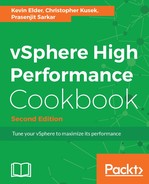DRS aligns resource usage with workload priority by automatically load balancing across hosts. It continuously monitors utilization across vSphere ESXi Servers and intelligently allocates available resources among VMs according to workload needs.
DRS aggregates vSphere ESXi host resources into clusters and automatically distributes these resources to VMs by monitoring the utilization and continuously optimizing VM distribution across vSphere ESXi hosts. DRS operates on a continuous 60-minute cycle in a default configuration.
It also continuously balances computing capacity in resource pools to deliver a level of performance, scalability, and availability that is not possible with a physical infrastructure.
DRS assigns priorities to its recommendations in the range of 1-5. The DRS migration threshold can be set from conservative (1) to aggressive (5). Depending on the migration threshold, DRS will apply recommendations at the corresponding priority and the ones below it. For example, if the migration threshold is set at 3, DRS will apply 1, 2, and 3 priority items and ignore 4 and 5 items. So, when you choose the DRS migration threshold, remember these two things:
- Moderate threshold, which is also the default setting, works well for most of the cases, for example, the majority of business applications that exhibit stable workload characteristics.
- However, you may wish to change the migration threshold of the following type of workloads in order to provide a more balanced workload distribution:
- Clusters that are homogenous
- Where resource demand for VMs is relatively constant
- Have few affinity and anti-affinity rules
Use affinity and anti-affinity rules only when absolutely necessary. The more rules that are used, the less flexibility DRS has when determining on which hosts to place VMs.
Also, always make sure that DRS is in automatic mode, cluster-wide. If you need more control over your critical VMs, override the cluster-wide setting by setting manual or partially automated mode on selected VMs. To change these options at the VM level, click on your DRS-enabled cluster, then go to the Configure tab and select VM Overrides under Configuration. Here you can add VMs and change their DRS configuration:

With the automatic mode cluster-wide setting, DRS can make migration recommendations only for the VMs that can be migrated with vMotion.
The following are some things to consider before you allow DRS to use vMotion:
- Ensure that the hosts in the DRS cluster have compatible CPUs. Within the same hardware platform (Intel or AMD), there might be differences in the CPU family, which means different CPU feature sets. As a result, VMs will not be able to migrate across hosts. However, Enhanced vMotion Compatibility (EVC) automatically configures server CPUs with Intel FlexMigration or AMD-V Extended Migration technologies so they could be compatible with older servers. EVC works by masking newer CPU features. Enabling EVC may require VM downtime if those newer features are in use. This prevents migrations with vMotion from failing due to incompatible CPUs.
- Leave some unused CPU capacity in your cluster for vMotion operations. When a vMotion operation is in progress, ESXi opportunistically reserves CPU resources on both the source and destination hosts. CPU resources are reserved to ensure the ability of vMotion operations to fully utilize the network bandwidth. The amount of CPU reservation thus depends on the number of vMotion NICs and their speeds: 10 percent of a processor core for each Gigabit Ethernet network interface is reserved. 100 percent of a processor core for each 10 Gigabit Ethernet network interface is reserved.
- The network configuration should be consistent across all the hosts in your DRS cluster. In addition, the VM network and the datastores on which the VMs reside should be available on all the hosts in your cluster.
- Disconnect VM devices that map to localhost devices, such as the local CD-ROM drive, the local floppy drive, local serial ports, and local USB ports.
-
For example, an MS cluster with raw device mapped could also prevent a VM from being migrated.
